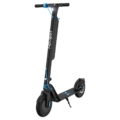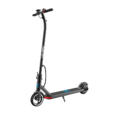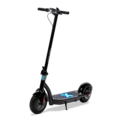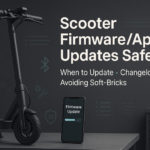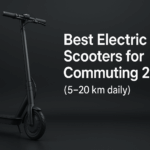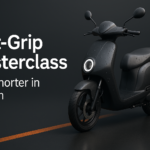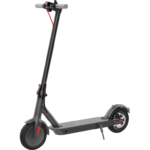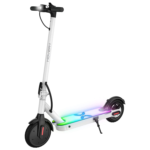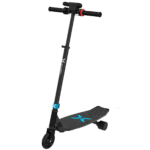- Home
- Scooters
- Electric Scooters
- Hover-1 Journey Max (H1-JNY-DM)
Hover-1 Journey Max (H1-JNY-DM)
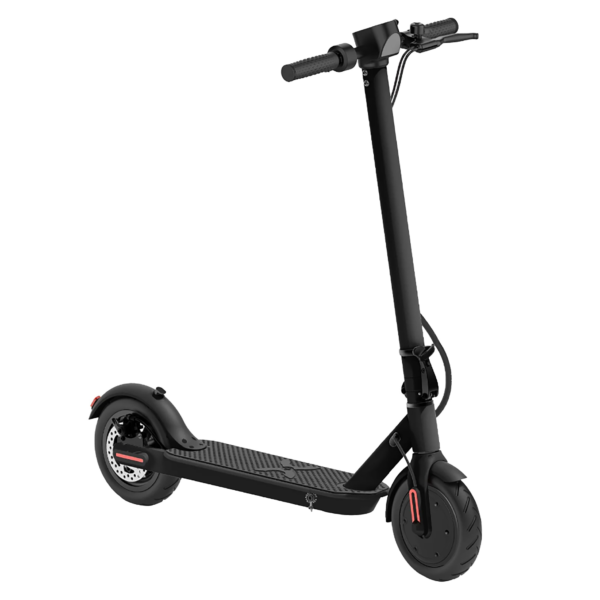


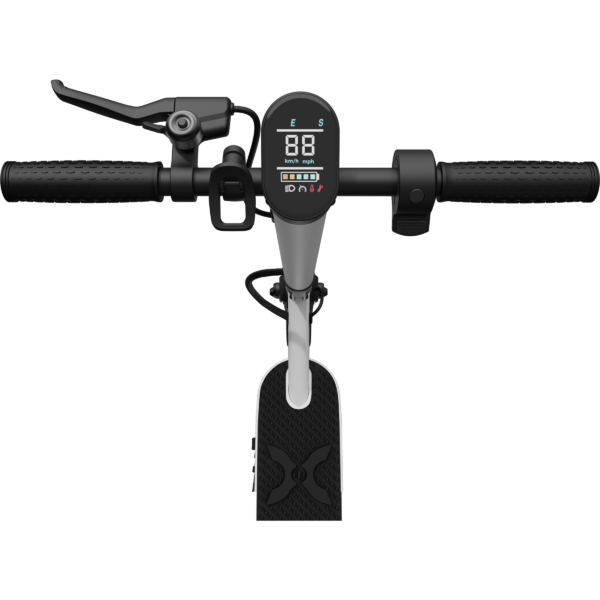
- Battery Range: 26 miles (41.8 km)
- Top Speed: 19 mph (31 km/h)
- Motor Power: 2 × 350 W dual hubs
- Weight Capacity: 264 lb (120 kg)
- Charging Time: ~5 h
- Scooter Weight: 44.8 lb (20.3 kg)
PROS
- Dual motors (front/rear selectable)
- Up to 26-mile range
- Rear disc brake
- 8.5″ pneumatic tires
- Upgraded LED display; 3 speed modes
CONS
- Heavier at ~44.8 lb
- IP rating not specified
- App integration not specified

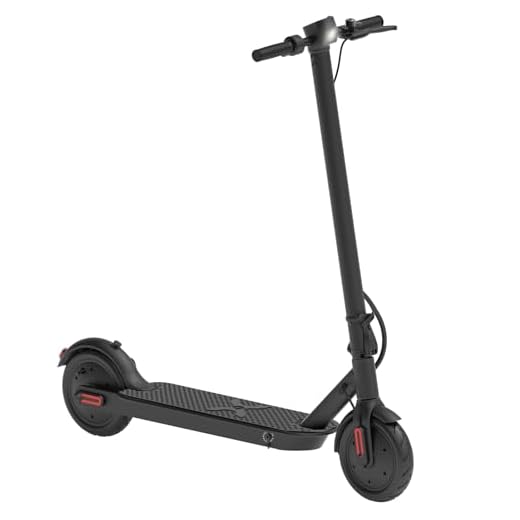
Table of contents
- What Is the Hover-1 Journey Max (H1-JNY-DM)?
- How the Hover-1 Journey Max (H1-JNY-DM) Works
- Key Specifications
- Design & Build Quality
- Performance Fundamentals
- Battery, Range & Efficiency
- Ride Quality & Comfort
- Braking & Safety Features
- Portability & Daily Usability
- Maintenance & Care
- Weather & Seasonal Considerations
- Hover-1 Journey Max (H1-JNY-DM) vs Alternatives
- Who the Hover-1 Journey Max (H1-JNY-DM) Is (and Isn’t) For
- FAQs
- Glossary
- Final Thoughts
The Hover-1 Journey Max (H1-JNY-DM) is a compact, dual-motor commuter scooter built for short to medium urban rides. It blends simple controls with a reinforced folding stem and a roomy deck, so new riders can settle in quickly while returning riders appreciate the extra pull on hills. Because it uses a 36 V pack and 8.5-inch air-filled tires, it aims for comfort and efficiency rather than brute force. If you want a straightforward ride that adds dual-motor punch without a steep learning curve, the Journey Max fits well. For cross-shopping, you can also consider the JOYOR LuxeRider as a comfort-oriented alternative.
What Is the Hover-1 Journey Max (H1-JNY-DM)?
At its core, the Hover-1 Journey Max is a portable, city-focused e-scooter with two 350 W hub motors (front and rear). Consequently, the layout totals 700 W nominal power and, in practice, gives you a noticeable boost when pulling away from stoplights, merging into a bike lane, or climbing small hills. The pack sits in the deck for a low center of gravity. Moreover, a 36 V lithium-ion battery (~13 Ah) powers the system, and a handle-mounted thumb throttle makes speed control intuitive. Braking is handled by a rear disc brake with a lever on the left. Because the Journey Max prioritizes ease over complexity, you get a clear LED display and simple speed/mode selections rather than a maze of menus.
This scooter is designed for pavement. The 8.5-inch pneumatic tires add a bit of natural suspension, while the sturdy, two-part folding column and secondary latch increase steering stability at speed. As a result, the maker positions it as an “entry-level dual-motor” commuter: easy to ride, reasonably quick up to 19 mph (30.6 km/h), and light enough to lift into a trunk or carry upstairs. Ultimately, these specifications make it a practical step-up from basic single-motor models.
How the Hover-1 Journey Max (H1-JNY-DM) Works
Motor & Controller. Each wheel houses a brushless hub motor rated at 350 W, controlled by an onboard ECU that meters current from the battery to the motors. Think of the controller as the scooter’s “cruise director”: it interprets throttle input, limits peak current to protect the pack, and balances power delivery to keep things smooth. Furthermore, it moderates response across ride modes so acceleration stays predictable.
Battery. The deck contains a 36 V lithium-ion battery (~13 Ah). Voltage determines the scooter’s “push,” while capacity (amp-hours) dictates how long you can maintain it. Multiply the two to estimate energy: 36 V × 13 Ah ≈ 468 Wh (or ~475 Wh if you reference a 13.2 Ah variant). Consequently, more watt-hours translate to more potential range—assuming the same riding style and conditions.
Throttle. A thumb-press throttle on the right sends a signal to the controller. Because it’s pressure-sensitive, you can feather it for slow maneuvers or press deeper for stronger acceleration. In practice, this design is beginner-friendly, and it keeps your wrist neutral on rougher pavement.
Brakes. A handle-activated rear disc brake provides stopping power. Mechanical discs are predictable and easy to maintain. Notably, bite increases with lever pressure; you’ll feel earlier slowing at a light squeeze and firm stopping after about half-lever travel.
Riding Modes. You can select speed modes (Eco/Drive/Sport) and choose single-motor or dual-motor drive. Eco reduces draw for longer rides; Drive balances pace and efficiency; Sport opens the taps for quicker sprints. In addition, dual-motor mode increases punch, especially when merging or tackling grades.
Key Specifications
The table below consolidates manufacturer-provided details, with metric equivalents for clarity. In brief, these specifications are tuned for everyday commuting rather than extreme performance.
| Block | Item | Spec |
|---|---|---|
| General | Model | H1-JNY-DM |
| Minimum rider weight | 44 lb (20 kg) | |
| Maximum rider weight | 264 lb (120 kg) | |
| Minimum recommended age | 16+ | |
| Performance & Power | Motors | Dual brushless hubs, 350 W each (700 W total) |
| Top speed (claimed) | Up to 19 mph (30.6 km/h) | |
| Claimed max range | Up to 26 mi (41.8 km) | |
| Drive selection | Single-motor or dual-motor | |
| Speed modes | Eco / Drive / Sport | |
| Battery, Charging & Electrical | Battery voltage | 36 V DC |
| Battery capacity | 13–13.2 Ah (≈ 468–475 Wh) | |
| Battery type | Lithium-ion | |
| Charge time (claimed) | ~5 hours | |
| Charger input | AC 100–240 V, 50/60 Hz | |
| Charger model | CP4220 | |
| Build & Dimensions | Tires | 8.5-in (216 mm) pneumatic, front & rear |
| Brake | Handle-activated rear disc | |
| Unfolded size (L×W×H) | 46.4 × 18.1 × 47.6 in (118 × 46 × 121 cm) | |
| Folded size (L×W×H) | 46.4 × 18.1 × 17.3 in (118 × 46 × 44 cm) | |
| Net weight | 44.77 lb (20.31 kg) | |
| Deck | Wider, longer standing platform | |
| Safety & Control | Lights | LED headlight |
| Display | LED digital display | |
| Recommended operating temp | 32–104 °F (0–40 °C) | |
| Features & Extras | Modes | Eco/Drive/Sport + single/dual motor selection |
| Cruise Control | Not specified | |
| Warranty & Compliance | Warranty | 6-month limited (parts & labor) |
| Notes | Check local riding laws; no published IP rating |
Design & Build Quality
The Journey Max focuses on practical stiffness and everyday ergonomics. The two-part folding mechanism with a secondary safety latch tightens the steering column, which helps reduce shimmy on choppy asphalt. Moreover, the stem feels stout for a commuter in this weight class, and the folding hinge’s lock engagement is positive. Because the deck houses the battery, the center of gravity sits low. Consequently, the scooter tracks predictably in a straight line and feels planted at cruise.
The deck is longer and wider than earlier single-motor versions in the family. Therefore, you can set a staggered stance for better balance and still shift foot positions on longer rides. The cockpit is uncluttered: a central LED display shows speed and battery, the right thumb throttle handles acceleration, and the left lever operates the rear disc. Since the scooter is built around 8.5-inch pneumatic tires, it benefits from sidewall compliance. Over expansion joints and paver seams, the tires take the edge off without the complexity of a spring fork.
Fit-and-finish is clean and functional. Cabling is routed sensibly, and the lever reach suits most hands. As with any cable-disc system, the initial pad alignment matters; once set, you will get a consistent lever feel. Additionally, the reinforced latch reduces the need for frequent hinge adjustments.
Performance Fundamentals
Acceleration feel. In single-motor mode, launch is smooth and measured. However, flip to dual-motor and you’ll notice stronger pull off the line, especially between 0 and ~12 mph. It will not snap like a high-voltage performance scooter; nevertheless, it gives you enough urgency to clear intersections confidently.
Cruising stability. At 15–19 mph (24–31 km/h) on decent pavement, the Journey Max feels steady. The reinforced column and latch help here, as does the low deck. Furthermore, because the tires are 8.5-inch pneumatic, they damp small chatter and keep the contact patch planted. On painted lines or wet leaves, ease off to maintain grip.
Hill-climb behavior. Short 7–10% grades are manageable in Sport + dual-motor mode if you keep momentum. Naturally, speeds will drop on longer climbs—normal for a 36 V commuter—but traction remains predictable if you stay centered and avoid abrupt throttle chops mid-slope. In other words, it prefers rolling terrain to big, sustained hills.
Battery, Range & Efficiency
The Journey Max uses a 36 V pack with ~13 Ah capacity. That equals roughly 468–475 Wh of energy, depending on the exact capacity variant. In ideal conditions, the maker claims up to 26 miles (41.8 km). Even so, real-world range varies with rider weight, route profile, temperature, and speed.
What changes range?
- Rider weight: Heavier riders draw more current. Accordingly, range shortens.
- Terrain: Rough asphalt and hills sap energy; conversely, flat bike paths stretch it.
- Speed & mode: Sport + dual-motor boosts fun but reduces miles; Eco extends them.
- Temperature: Below 40 °F (4 °C), lithium cells deliver less, so plan conservatively.
- Tire pressure: Under-inflation increases rolling resistance and risk of flats.
Charging. A full charge is listed at about five hours with the included charger. For longevity, allow the pack to cool after a hard ride before plugging in. Additionally, do not repeatedly store the scooter at 0% or 100% for weeks. If you will not ride for a while, leave it around 50–70% and top up monthly. Taken together, these habits support steady capacity retention.
Ride Quality & Comfort
Tires. The 8.5-inch air-filled tires are the star of the comfort story. They add compliance over joints and offer a familiar, predictable cornering feel. To keep that feel consistent, maintain proper pressure; otherwise, the ride dulls and range suffers.
Ergonomics. The thumb throttle is friendly for stop-and-go traffic, and the lever reach suits a wide range of hand sizes. Hand numbness is rare at commuter speeds; however, if you feel buzz through the grips on rough chip-seal, a small glove helps. Likewise, minor bar-angle tweaks can improve wrist comfort.
Stem flex. Commuter stems always flex a little. Nevertheless, the two-part folding mechanism and latch noticeably firm up the column. As a result, the bar feels composed when you look over your shoulder or change lanes on smooth pavement. Additionally, that firmer column can help reduce speed wobble at the top of the scooter’s range.
Noise & vibration. Brushless hubs are quiet. Mostly, you’ll hear tire hum and the occasional rattle from items clipped to the handlebar. If you notice cable chatter on bumps, a small zip tie or a stick-on frame pad can silence it. Similarly, periodic bolt checks prevent new rattles from developing.
Braking & Safety Features
Rear disc brake. The mechanical disc offers intuitive control. Initial bite is mild; then braking ramps up as you squeeze deeper. Therefore, practice progressive braking in an empty lot to learn your lever travel, and rehearse emergency stops from 12–15 mph. You will stop straight if you keep eyes up and weight centered.
Lights & visibility. The LED headlight gives you basic “be seen” visibility at dusk. Because there are no factory reflectors specified for this model, consider reflective clothing or a small accessory blinker for night commutes. Meanwhile, ride in well-lit areas whenever possible and keep the lens clean.
Water & weather. There is no published IP rating. Consequently, treat rain and puddles as off-limits. Slow down on slick surfaces, skip standing water, and store the scooter indoors. Additionally, wipe moisture away after humid rides to protect hardware.
Portability & Daily Usability
Weight & carry. At 44.77 lb (20.31 kg), it is heavier than many single-motor commuters but still manageable for short stair flights. Use the stem as a carry point and keep the deck against your leg for balance. If you need frequent carry-ups, plan rest points.
Folding. The fold is straightforward: drop the stem, engage the latch, and verify lock. Because the hinge is robust, it closes with a definitive “set.” Always check both the primary catch and the safety latch before riding; otherwise, a loose column invites wobble. After folding, confirm that cables are not pinched.
Storage. Folded dimensions—46.4 × 18.1 × 17.3 in (118 × 46 × 44 cm)—slide into a trunk or under a desk. When storing, keep it dry and ventilated, away from heat sources. Furthermore, if you commute by rail, mind weight limits and rush-hour etiquette to avoid blocking doors.
Security. As with most scooters, frame lock points are limited. A compact U-lock through the rear wheel and an auxiliary cable around a fixed object add deterrence. For daily use, bring the charger so you can top up at work, and avoid leaving the scooter outside overnight.
Maintenance & Care
Tire pressure. Check weekly. Proper inflation maintains range and handling. Because tires are 8.5-inch, they’ll feel sluggish if under-inflated and harsh if over-inflated. Therefore, aim for the middle of the recommended range and adjust for comfort.
Brakes. Cable discs stretch slightly over time. If the lever travel grows long, dial in the barrel adjuster or nudge the caliper inward. Additionally, replace pads when bite fades or you hear consistent scraping. Remember, clean rotors stop better.
Fasteners. Vibrations loosen screws. Do a monthly bolt check: stem hinge bolts, handlebar clamp, brake caliper, rotor bolts, and fender screws. Use blue threadlocker where appropriate. Likewise, inspect cable routing to prevent rub.
Battery habits. Avoid storing at empty or full for long periods. Keep it at room temperature; extreme heat and cold accelerate degradation. If you ride in winter, bring the scooter inside to warm before charging. In the long run, these habits help preserve capacity.
Charger & ports. Use the included charger only. Check the port cap after charging to keep dust out. If the charger runs hot, place it on a hard, ventilated surface. Finally, avoid coiling the cable tightly; gentle loops extend its life.
Simple schedule.
- Before rides: Tire pressure, brake lever feel, hinge latch check. Additionally, glance at the display for battery level.
- Weekly: Quick bolt check, pad/rotor look, wipe the deck and lights.
- Monthly: Cable tension, caliper alignment, deep clean, battery health glance.
- Seasonal: Tire inspection/replacement, full fastener audit, grip refresh.
Weather & Seasonal Considerations
Rain. Because there’s no IP rating, treat rain as off-limits. Slick surfaces and water ingress can harm electronics and compromise brakes. If you are caught in a surprise shower, slow down, shorten your ride, and dry the scooter thoroughly before storing. Afterward, check the brake rotor for surface rust and wipe it clean.
Heat. Above 86–95 °F (30–35 °C), batteries and controllers work harder. Therefore, park in the shade, avoid blacktop baking, and let the pack cool before charging. Heat ages cells; moderation helps.
Cold. Below 40 °F (4 °C), you will notice reduced punch and range. This is normal. Pre-warm the scooter indoors, ride in Eco when possible, and charge at room temperature. Furthermore, expect slightly longer charge times when the pack is cold.
Seasonal storage. For off-season downtime, store the scooter dry at 50–70% state of charge and top up monthly. Additionally, keep the tires off a cold concrete floor if you have a garage; a mat reduces flat-spotting.
Hover-1 Journey Max (H1-JNY-DM) vs Alternatives
Within commuter class. Against single-motor commuters, the Journey Max’s dual motors deliver stronger starts and better confidence on rolling terrain. It carries extra weight compared with many single-hub peers; however, the payoff is traction and stability.
Against performance scooters. True performance models will outrun and out-climb the Journey Max, but they weigh more and demand more attention to throttle control. Consequently, if you do not need 30+ mph performance, the Journey Max keeps things simpler and more manageable day-to-day.
Against off-roaders. Off-road scooters add suspension, knobby tires, and rugged frames. By contrast, the Journey Max is not meant for trails or sand; its 8.5-inch street tires and fenders are tuned for city streets and bike paths.
Where it excels. Dense urban commutes, mixed bike-lane riding, and campus travel where 19 mph top speed is sufficient. Additionally, it’s a smart step-up for someone outgrowing a single-motor 36 V scooter but not ready for 52–60 V machines. Altogether, the package favors predictability and ease.
Who the Hover-1 Journey Max (H1-JNY-DM) Is (and Isn’t) For
Great for:
- Daily commuters covering 3–8 miles each way on pavement.
- Students and multi-modal riders who fold, carry, and store at class or work.
- Beginner to intermediate riders who want dual-motor traction without complex settings.
- Riders up to 264 lb (120 kg) who need a sturdy deck and predictable handling.
Not ideal for:
- Wet-weather riders who must commute in rain.
- Long, steep hills beyond short 7–10% sections; range and speed will taper.
- Off-road use or rough, unpaved routes.
- Ultra-light carry needs; at ~45 lb, it is not a featherweight.
If your riding is mostly paved, stop-and-go, and storage-constrained, the Hover-1 Journey Max (H1-JNY-DM) meets the brief with fewer trade-offs than you might expect in this weight and size class. Crucially, its specifications support balanced city performance without overwhelming new riders.
FAQs
1) How fast does it go?
Up to 19 mph (30.6 km/h) in ideal conditions, with the strongest acceleration in Sport + dual-motor mode. Additionally, single-motor mode conserves energy.
2) What is the real-world range?
The claim is up to 26 mi (41.8 km). Actual range depends on rider weight, terrain, temperature, tire pressure, and speed mode. Therefore, plan with a margin.
3) Does it have suspension?
No traditional springs. Instead, comfort comes from 8.5-inch pneumatic tires, which flex to absorb small bumps and cracks.
4) Is there cruise control?
The manufacturer does not specify cruise control for this model. Nevertheless, it provides speed modes and single/dual-motor selection for flexible pacing.
5) Can I ride it in the rain?
There is no published IP rating, and wet use is discouraged. Consequently, avoid rain and puddles and store the scooter indoors.
6) What comes in the box?
Scooter, charger, charging cable, a hex key and bolts, plus spare bolts. Additionally, you’ll find a user manual and basic safety info.
7) Where can I find a “Hover-1 Journey Max (H1-JNY-DM) overview” of key specs?
See the Key Specifications section above for a concise, metric-inclusive summary of the main specifications.
Glossary
- Ah (Amp-hour): Battery capacity; larger numbers usually mean more range.
- Wh (Watt-hour): Battery energy (V × Ah); useful for comparing different batteries.
- Brushless hub motor: A motor built into the wheel; efficient and low-maintenance.
- Controller: The scooter’s electronic “brain” that meters battery current to the motors.
- Thumb throttle: A lever pressed by the thumb to command speed.
- Regen: Electronic braking that returns energy to the battery; not specified here.
- Stem flex: Small movement in the folding column under load; affects steering feel.
- IP rating: Ingress Protection score for dust/water; none published for this model.
- Disc brake: A caliper squeezes pads onto a rotor for stopping power.
- Pneumatic tire: Air-filled tire that adds comfort and grip.
- Dual-motor mode: Both hubs power the scooter for stronger acceleration and hill starts.
- Eco/Drive/Sport: Speed and power presets; Eco saves energy, Sport maximizes thrust.
- Nominal power: A motor’s continuous rating; peak power may be higher briefly.
- Deck: The platform you stand on; houses the battery in this model.
- UL mains input: The charger’s wall-side power (100–240 V AC) rating for global use.
Final Thoughts
If you want a commuter scooter that keeps the controls simple yet adds dual-motor assurance, the Hover-1 Journey Max (H1-JNY-DM) is a practical choice. It prioritizes stability, approachable speed, and everyday portability. Moreover, the pneumatic tires and reinforced stem make urban miles calmer than you might expect. Respect the weather guidance, maintain the tires and brakes, and you’ll have a reliable, easy-to-live-with ride. In summary, the package balances weight, range, and specifications that suit real-world city use.
Specifications
General
| Model The Model specifies the exact version or name of the scooter. It helps identify its unique design, features, and specifications within the manufacturer’s product line. Knowing the model makes it easier to compare options, find compatible accessories, or look up support information. | Journey Max (H1-JNY-DM) |
| Brand The Brand identifies the manufacturer or company that designs and produces the scooter. A trusted brand is a sign of quality, reliability, and good customer support. Well-known brands often have higher standards for safety, performance, and after-sales service, giving you more confidence in your purchase. | Hover-1 |
| Release Date The Release Date indicates when the scooter model was officially launched on the market. This helps you know how current the design, technology, and features are. A newer release date often means updated components, improved performance, and the latest safety or smart features. | 17 November 2025 |
| Recommended Age Recommended Age indicates the minimum age range that the scooter is designed for, based on safety, size, and ease of use. Following the recommended age helps ensure that riders can handle the scooter’s speed, weight, and controls comfortably and safely. Always check local laws and use protective gear, especially for younger riders. | 16+ |
Performance & Power
| Motor Power (Wattage) What it means: The motor power, measured in watts (W), shows how strong the scooter’s electric motor is. Why it matters: Higher wattage usually means better acceleration, more torque, and improved performance on hills or rough terrain. For example, a 250W motor is good for flat city roads and light riders, while a 500W or 1000W motor provides more power for faster speeds or climbing steep inclines. | 2 × 350 W dual brushless hub motors |
| Top Speed The Top Speed indicates the maximum speed that the scooter can reach under optimal conditions. It’s usually measured on level ground with a fully charged battery and an average rider weight. A higher top speed allows you to travel longer distances faster, but always ensure you ride within legal speed limits and your personal comfort zone for safety. | 19 mph (31 km/h) |
| Battery Capacity Battery Capacity refers to the total amount of energy the scooter’s battery can store, usually measured in ampere-hours (Ah) or watt-hours (Wh). A higher battery capacity means you can ride longer distances on a single charge, reducing the need for frequent recharging. Keep in mind that actual range can vary depending on rider weight, terrain, speed, and weather conditions. | 36 V 13.2 Ah (475 Wh) |
| Estimated Range per Charge The Estimated Range per Charge indicates the average distance the scooter can travel on a single full battery charge. This range is calculated under optimal conditions, such as flat terrain, moderate speed, and average rider weight. Real-world range may vary depending on riding style, terrain, weather, and load. A longer range means fewer recharges and greater freedom for longer trips. | up to 26 miles (41.8 km) |
| Hill Climb Ability Hill Climb Ability describes the maximum incline or slope that the scooter can handle while maintaining stable performance. It’s typically expressed as a percentage or in degrees. A higher hill climb rating means the scooter can tackle steeper hills without losing too much speed or power. Actual climbing performance may vary based on rider weight, battery charge, and terrain conditions. | up to 25° (claimed) |
| Drive System The Drive System refers to how power from the motor is delivered to the wheels. Electric scooters typically use either a hub motor (directly integrated into the wheel) or a chain/belt drive system. A high-quality drive system ensures smooth acceleration, efficient power transfer, and low maintenance. The choice of drive system affects performance, noise level, and overall ride experience. | Dual hub (2WD) with single/dual selection |
Charging & Electrical
| Charging Time Charging Time indicates how long it takes to fully recharge the scooter’s battery from empty to 100% using the standard charger provided. Faster charging means less downtime and more time on the road. Actual charging time may vary slightly depending on battery capacity, charger output, and environmental conditions. | Approx. 5 hours |
| Battery Type Battery Type refers to the specific technology used in the scooter’s battery, which affects performance, lifespan, weight, and charging time. Most modern electric scooters use high-quality lithium-ion (Li-ion) batteries because they offer a good balance of energy density, durability, and low maintenance. A reliable battery type ensures consistent power delivery and longer riding ranges. | Lithium-ion battery (BMS not specified) |
| Removable Battery A Removable Battery means the battery pack can be easily detached from the scooter for convenient charging and replacement. This feature allows you to charge the battery separately, swap it with a spare for extended range, or securely store it indoors in extreme weather. Removable batteries add flexibility and make it easier to keep your scooter powered up wherever you are. | Non-removable internal battery (fixed pack) |
| Regenerative Braking Regenerative Braking is an energy-saving feature that converts some of the energy normally lost during braking back into battery power. When you slow down or brake, the motor works in reverse to generate electricity, which helps extend the scooter’s range and improves overall efficiency. This system also reduces wear on traditional brake components, leading to lower maintenance over time. | Not specified |
| Lighting Lighting refers to the built-in front and rear lights that enhance visibility and safety when riding in low-light conditions or at night. Good lighting helps you see the road ahead and ensures that other road users can see you. Many scooters include LED headlights, taillights, and sometimes brake lights or side reflectors for added safety and compliance with local traffic regulations. | LED headlight + rear LED/brake; reflectors |
Build & Dimensions
| Scooter Weight Scooter Weight refers to the total weight of the scooter when fully assembled, including the battery. This affects how easy it is to carry, lift, and store the scooter when not in use. A lighter scooter is more portable and convenient for commuting, especially if you need to carry it upstairs or onto public transport. Keep in mind that a sturdy frame and quality components may add to the weight but also contribute to better durability and ride stability. | 44.8 lb (20.3 kg) |
| Maximum Rider Weight Maximum Rider Weight indicates the highest rider weight that the scooter is designed to safely support while maintaining optimal performance and stability. Staying within this limit helps ensure reliable acceleration, braking, and climbing ability, and it protects the frame, suspension, and motor from excessive strain. Exceeding the recommended limit may reduce performance and increase wear on components. | 264 lb (120 kg) |
| Deck Size Deck Size refers to the dimensions of the scooter’s standing platform. A wider and longer deck provides more foot space, allowing you to stand comfortably and adjust your stance while riding. A well-sized deck improves balance and stability, especially on longer rides or at higher speeds. Compact decks, on the other hand, help keep the scooter lightweight and portable. | Two-part folding with safety latch |
| Handlebar Height Handlebar Height refers to the distance from the deck to the handlebars, which affects your riding posture and comfort. An appropriate handlebar height helps you maintain good balance, reduces strain on your back and arms, and makes steering more comfortable. Some scooters have adjustable handlebars to fit riders of different heights, while others have a fixed height for a streamlined design. | Fixed |
| Folding Mechanism The Folding Mechanism describes how easily and securely the scooter can be folded for carrying and storage. A well-designed folding system lets you quickly collapse the scooter into a compact size, making it convenient to transport on public transit, store under a desk, or fit into a car trunk. Look for sturdy latches and safety locks to ensure the scooter stays firmly in place when folded or unfolded. | Reinforced two-part latch, quick fold |
| Dimensions Folded Dimensions indicate the size of the scooter when it’s fully folded. This measurement shows how much space the scooter will take up when stored or carried, making it easier to check if it will fit in your car trunk, under a desk, or in a closet. Compact folded dimensions are ideal for commuters who need to bring their scooter on public transport or store it in tight spaces. | Folded: 46.4 × 18.1 × 17.3 in (117.9 × 46.0 × 44.0 cm); Unfolded: 46.4 × 18.1 × 47.6 in (117.9 × 46.0 × 121.0 cm) |
| Material Material refers to the primary construction materials used for the scooter’s frame and key components. High-quality materials like aircraft-grade aluminum, reinforced steel, or durable composites provide strength, stability, and a lighter overall weight. A sturdy material ensures the scooter can handle daily wear and tear while maintaining safety and performance. | Aluminum alloy |
Safety & Control
| Brake Type(s) Brake Type(s) describe the braking systems the scooter uses to help you slow down or stop safely. Common brake types include mechanical brakes (like drum or disc brakes), electronic brakes, and foot brakes. Many scooters combine multiple braking systems for added safety and shorter stopping distances. The type and quality of brakes affect your control, especially when riding at higher speeds or on slopes. | Rear disc brake |
| Suspension Suspension refers to the system that absorbs shocks and vibrations while riding, providing a smoother and more comfortable ride over uneven or rough surfaces. Scooters may have front suspension, rear suspension, or dual suspension for better shock absorption and stability. Good suspension helps reduce rider fatigue and improves control, especially when riding on bumpy roads or off-road paths. | None |
| Tire Type Tire Type refers to the kind of tires the scooter uses, which directly affects ride comfort, traction, and maintenance. Common types include solid (airless) tires, pneumatic (air-filled) tires, or hybrid options. Pneumatic tires offer better shock absorption and a smoother ride on rough surfaces, while solid tires are puncture-proof and require less upkeep. The right tire type helps ensure safe handling and a comfortable ride in different conditions. | 8.5″ pneumatic street tires |
| Tire Size Tire Size indicates the diameter and width of the scooter’s tires, which affect ride comfort, stability, and how well the scooter handles different terrains. Larger tires generally offer better shock absorption and a smoother ride over bumps and rough surfaces, while smaller tires keep the scooter lighter and more portable. Choosing the right tire size helps ensure a balance between agility and comfort. | 8.5-inch |
| Kickstand The Kickstand is a built-in stand that allows you to park your scooter upright when it’s not in use. A sturdy kickstand keeps the scooter stable and prevents it from tipping over, protecting it from scratches and damage. It also makes storing and accessing your scooter more convenient, whether you’re at home, work, or on the go. | Side kickstand |
| Water Resistance Rating Water Resistance Rating indicates how well the scooter is protected against water and moisture, usually shown as an IP (Ingress Protection) rating. This rating helps you understand whether the scooter can handle light rain, splashes, or wet roads without damage. While most scooters are not fully waterproof, a good water resistance rating adds peace of mind when riding in changing weather conditions. Always avoid deep puddles or submerging the scooter to protect its electrical components. | Not specified |
Features & Extras
| Display/Console The Display (or Console) shows important real-time information about your ride, helping you monitor your scooter’s status at a glance. Typical displays show speed, battery level, distance traveled, and riding mode. Some models also include additional features like Bluetooth connectivity, app integration, or backlighting for better visibility at night. A clear and easy-to-read display enhances safety and convenience on every trip. | LED display (speed, battery, modes) |
| Ride Modes Ride Modes refer to the different speed and power settings you can choose to match your riding style or road conditions. Common modes include eco for maximum range and energy efficiency, standard for everyday balance, and sport or turbo for higher speed and stronger acceleration. Switching between ride modes allows you to customize performance, conserve battery, and ride safely in various environments. | Eco/Drive/Sport (3 modes) |
| Smart App Connectivity Smart App Connectivity lets you pair your scooter with a dedicated mobile app via Bluetooth. Using the app, you can monitor real-time ride stats like speed, battery level, and range, adjust settings such as ride modes or cruise control, lock the scooter for added security, and sometimes receive firmware updates. This feature adds convenience and allows you to personalize your riding experience right from your smartphone. | Not specified |
| Anti-Theft System The Anti-Theft System helps protect your scooter from unauthorized use or theft. This feature can include built-in alarms, electronic motor locks, GPS tracking, or remote locking through a mobile app. A good anti-theft system provides peace of mind when parking your scooter in public spaces, adding an extra layer of security to safeguard your investment. | Not specified |
| Cruise Control Cruise Control allows you to maintain a steady speed without continuously holding the throttle. This feature makes longer rides more comfortable by reducing hand fatigue and providing a smoother, more relaxed riding experience — especially on flat, open roads or bike lanes. For safety, cruise control can usually be easily activated or deactivated while riding. | Not specified |
| Accessories Included Accessories Included lists the additional items that come with the scooter to enhance your riding experience and convenience. Common accessories may include a charger, kickstand, bell, lights, phone holder, or carrying strap. These extras add value by making your scooter safer, easier to use, and ready to ride straight out of the box. | Scooter, wall charger, manual |
Warranty & Compliance
| Warranty Period The Warranty Period indicates how long the manufacturer guarantees the scooter against defects in materials and workmanship under normal use. A good warranty provides peace of mind, showing the brand’s confidence in its product quality. Always check what parts are covered, such as the frame, battery, and motor, and follow the maintenance guidelines to keep your warranty valid. | 6 months (limited; region-dependent) |
| Certifications Certifications confirm that the scooter meets specific safety, quality, and environmental standards set by recognized organizations or regulatory bodies. Common certifications may include CE, RoHS, UL, or other local compliance marks, depending on your region. These certifications ensure that the scooter is manufactured to high standards and is safe and legal to use in your country. | UL 2272 mentioned by retailers; local micromobility rules apply |
Price Comparison




